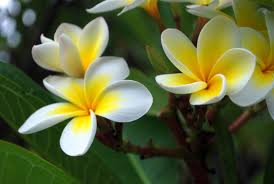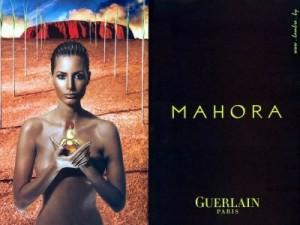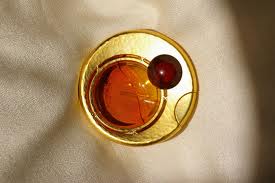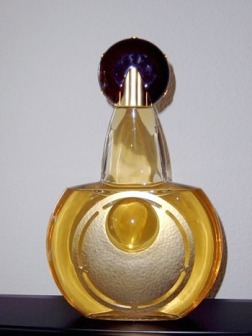I have a perpetual tendency to root for the under-dog. And I’m also naturally inquisitive, especially about things that are notorious. Which brings to me to Mahora, the beleaguered, endlessly trashed, and notorious last fragrance of Jean-Paul Guerlain for the House that bears his name.
Common reactions to Mahora range from “Worst. Perfume. EVER!” to comments about mosquito repellents or suntan lotions. Luca Turin — that endlessly acerbic perfume critic (with whom I often disagree, by the way) — apparently compared this to a $200 plug-in air freshner and called it Guerlain’s worst fragrance. It’s a fragrance sometimes nicknamed “My Whore,” due not only to its pronunciation in certain accents but also, undoubtedly, due to its over-ripe nature. And, yet, there are also numerous raves about its lushness and its heady, fearless, almost comfortingly exotic character. How could I possibly resist seeing what all the fuss was about?!
Mahora was released in 2000 in Eau de Parfum form as an homage to the island of Mahore (or Mayotte) where Guerlain has plantations of jasmine and ylang-ylang. It is a tropical, slightly fruity, super floral with an oriental dry-down. It is also the least Guerlain-like fragrance imaginable!
That difference probably explains, in part, why it was a complete and an utter bomb in the marketplace; Guerlain buyers used to things like Jicky, Shalimar or even, Jardins de Bagatelles, were undoubtedly bewildered by such a Hawaiian island fragrance.
Quietly discontinued just two years or so after its debut, Mahora was later re-released in 2006 with a name change. It was now called Mayotte and was included in Guerlain’s  Les Parisiennes collection (supposedly with a significant price increase as a result). You can still find Mahora easily and relatively inexpensively on eBay (where I bought my bottle) for between $15 and $60, depending on size and seller. Mayotte, in contrast, is reportedly available only at the Guerlain store in Paris and at Bergdorf Goodman in New York where it retails for $270. We’ll get to the comparisons between the two fragrances shortly and whether either one is worth a shot.
Les Parisiennes collection (supposedly with a significant price increase as a result). You can still find Mahora easily and relatively inexpensively on eBay (where I bought my bottle) for between $15 and $60, depending on size and seller. Mayotte, in contrast, is reportedly available only at the Guerlain store in Paris and at Bergdorf Goodman in New York where it retails for $270. We’ll get to the comparisons between the two fragrances shortly and whether either one is worth a shot.
According to Aromascope and other sites, Mahora’s notes are as follows: orange, almond tree blossoms, ylang-ylang, neroli, tuberose, jasmine, sandalwood, vetiver, and vanilla. What almost none of these official notes include — but which almost everyone can detect — is frangipani. Frangipani is also known as plumeria, a flower common to  tropical climates like Mexico or South America but also to such exotic islands as Fiji, Tahiti and Hawaii. It has a very heavy, heady, lushly ripe, extremely sweet scent similar to magnolia, gardenia and tuberose. It can also bring to mind coconuts. (All of which make the Australian desert landscape of the Mahora commercial rather odd, in my mind.)
tropical climates like Mexico or South America but also to such exotic islands as Fiji, Tahiti and Hawaii. It has a very heavy, heady, lushly ripe, extremely sweet scent similar to magnolia, gardenia and tuberose. It can also bring to mind coconuts. (All of which make the Australian desert landscape of the Mahora commercial rather odd, in my mind.)
Frangipani is best described as an “indolic” scent, meaning over-ripe, almost to the point of decay. Tuberose is another very indolic flower which is why extremely creamy, ripe tuberose scents can — on some people — bring to mind feces or a cat’s litter box. (You have no idea how many people shy away from anything involving tuberose. If there is any scent that seems to strike fear in the heart of many women, it seems to be tuberose. I should confess that I adore tuberose and it’s my favorite flower in general.) Indolic scents are not easy one, and combining frangipani with tuberose and jasmine was a brave, brave move. (One which apparently fell flat on its nose, judging by some of the extremely harsh reviews.) I have absolutely no idea why frangipani is not included on the official perfume notes, but there is zero doubt in my mind (and that of many others) that it’s included. In fact, I would go so far as to say that extremely indolic frangipani is the foundation to Mahora.
When I first sprayed Mahora, I did so carefully and gingerly. This is a perfume known to be a powerhouse. It’s been compared to such notoriously heady 80s blockbusters as Poison and Giorgio, or other infamously strong scents like Amarige and Opium. So I gently lowered the rather awkward blue top and gave a few squirts. And what I got was not the expected orange notes I’d read about but, rather, green notes. Ripe, not crisply fresh, but most definitely green notes. A burst of the vetiver, perhaps? If so, this was like no vetiver I’d ever smelled because the overall result was like dirty water in a vase of rotting flowers that hadn’t been changed in a week. (Perhaps vetiver shouldn’t be mixed with tuberose by anyone but the Piguet perfumers who make Fracas. I love Fracas. This is no Fracas.)
The smell of filthy, murky, green, vase water was soon joined by coconut, sandalwood and what seemed to be almond tree. Not almond tree blossoms, but rather, the woody notes of a slightly moist, aged, possibly decaying tree bark. This too was…. unexpected and off-kilter. And it lasted a good 10 minutes or so, until it turned to a coconut sunscreen effect (mixed with the slightly brackish, rotten vegetal water scent) over a smell of buttered white flowers. Yes, buttered. As in buttered popcorn mixed with very heady tuberose and white flowers. I feel as though I’m wearing a dose of AMC Cinema’s popcorn butter mixed with white flowers and coconut. And, yet, it’s not Hawaiian Tropic suntan lotion, it’s not even Bain de Soleil (which I used to love) because of those blasted almond tree, wood, vetiver and green notes!
It’s perplexing. This is nothing like what I expected — which was a giant white floral with tropical elements. The initial scent is off-putting, unconventional and disorienting in the way of niche houses, like Serge Lutens. Just as his Tubéreuse Criminelle turns things upside down and on their head with a camphorous green note to the tuberose, the Mahora is very far from a mainstream, white tuberose scent in its initial opening bouts. It’s even further from most Guerlain fragrances, though I’ve seen some understandable comparisons to Guerlain’s Samsara. I think Jean-Paul Guerlain sought, perhaps, to make a tropical, exotic version of Samsara here. I simply don’t think he succeeded. (That said, I should confess that Samsara is not one of my favorite Guerlains either.)
An hour in, and Mahora is all big white flowers. It’s too exotic and tropical to be compared to Fracas or to some Estée Lauder variation. It’s got too much frangipani to really compare. It’s also starting to fade on me. I speak often of how my body consumes perfume but really, I expected this one to last! All the endless comments about migraines, monster sillage and longevity and I get maybe two hours of full scent before it starts to become closer to the skin. I think that, as the frangipani/coconut recedes and the other, softer white flowers come more to the foreground, Mahora starts to become less brash and heady. It’s calmer now, though I still smell the coconut.
Three hours in, the coconut has finally left the building and the Guerlain signature has entered. Mahora has unfurled into a creamy, vanilla with sandalwood and only a hint of the white flowers. It’s also started to develop of touch of that famous Guerlinade. “Guerlinade” refers to that Guerlain note which is a signature on most of their perfumes at the foundational element and which wafts through the dry-down with a very powdery (sometimes slightly vanilla-tinged) accord. I smell a wisp, possibly just in my imagination, of the jasmine but it’s faint. One thing is clear, however: Mahora has turned into a Guerlain oriental. All in all, Mahora lasted about 5 hours on me, which was considerably less than the enormous amount of time reported for the fragrance by most commentators.
While most commentators say that Mahora and its successor, Mayotte, are identical, there are some who disagree. The experts at CaFleureBon certainly see a difference in an article entitled “Sexy Sadie Thompson of M. Somerset Maugham’s Rain.” Another site, Aromascope (linked up above) compares the two fragrances as follows:
While Mayotte is an ode to ylang-ylang, Mahora dignifies tuberose. […] I find Mayotte much more Guerlain-like: it possesses the same peachy heft of Mitsouko. Mahora, on the other hand, strikes me as rather aggressive and mutinous. Its sugared, almost oily tuberose seems to defy all things Guerlain, and perhaps that’s the reason the fragrance didn’t do so well. In spite of being much more refined and polished, Mayotte can hardly be called a tame and acquiescent version of Mahora – it bears but faint sibling resemblance and respectfully begs to differ. While Mahora is heady and persistent, Mayotte is soft and enveloping and has won my heart as the best ylang-ylang scent ever created.
Others sharply disagree and say that there is absolutely no difference between the two scents. Still others say that Mayotte is simply a weaker eau de toilette concentration of Mahora, though the fact that both are officially listed as “eau de parfum” seems to counter that theory.
So, is it worth trying? I’ve seen one reviewer argue that, if Mahora had been released now and under the Serge Lutens label, “as a hoity-toity luxury perfume, it would be resounding [sic] a success among sophisticated perfumistas.” I can see the point and rationale. I think I may even agree, particularly when remembering Mahora’s unexpected opening and when thinking about Serge Lutens Datura Noir. I found the latter significantly underwhelming, though it’s been long enough since I last tried it that I can’t recall all the details of why. It certainly shares a similar coconut and tuberose trait, though!
In the end, it’s a fragrance that only a white-flower lover may like and, even then, it’s not breath-taking or particularly special, outside of its history and notoriety. (For purposes of balance, my memories of the famous Serge Lutens Datura Noir, and indeed a number of his fragrances, also rank in the “not particularly special” category.) Do I regret buying a full bottle? No, not really. I rarely regret buying perfume, especially not one that is hard to find, discontinued, and controversial to boot. It’s worth it for me just to have it for my collection and for being able to know it. I also like being able to make up my own mind about super polarising scents. And, lastly, I can always find a use for some perfume or another. (With the exception of Montale’s Lime Aoud which is truly THE worst thing I have ever smelled!)
However, I would not feel that way if Mahora were not so cheap on eBay. There is absolutely NO way on God’s green earth that I would pay $270 (not including tax) for the Mayotte version. None. I bought my 1.7 oz bottle of eau de parfum for $23 or so! For that cost, Mahora is a fun, exotic, tropical white flowers oriental perfume that I can wear in winter before going to bed and when I want to mentally escape to Fiji. For $23, I get to see what all the fuss is about.
And that fuss is definitely not worth $270.



